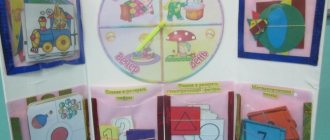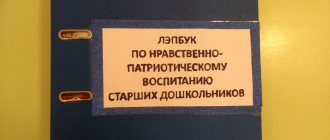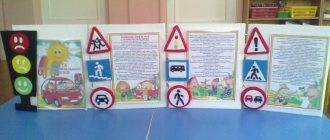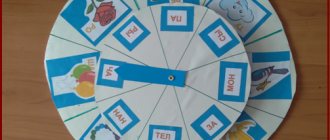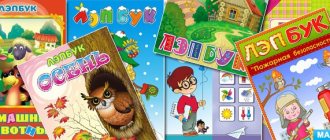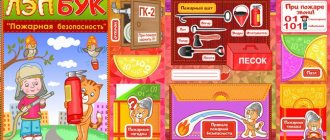MAGAZINE Preschooler.RF
Lapbook “Healthy lifestyle”Municipal budgetary preschool educational institution kindergarten No. 5 “Lastochka” , Pavlovo
Completed by teacher: N.O. Semenov
The laptop “Healthy Lifestyle” is designed for working with children of middle preschool age to introduce children to a healthy lifestyle. A healthy lifestyle is the activity of people aimed at maintaining and improving health.
The purpose of the lapbook: To form a system of knowledge, skills and abilities for children to develop a healthy lifestyle.
Tasks:
- Formation of a conscious attitude towards their health in children
- Development of cognitive interest, expansion of children's horizons
- Enrichment and activation of vocabulary in children.
The lapbook includes various information:
- Winter sports. Goal: Expand and consolidate children's knowledge about winter sports.
- Summer sports. Goal: Developing interest in summer sports.
- Useful and harmful. Goal: To form in children an idea of healthy foods and harmful foods.
- The ABC of health. Goal: Formation of a value-based attitude towards health and a healthy lifestyle.
- Coloring pages. Goal: Development of fine motor skills, attention, memory, consolidation of knowledge of color, shape, cultivation of perseverance, accuracy, independence.
- Puzzles. Goal: To develop hand motor skills, attention, logical thinking, perseverance.
- Didactic game “assemble an algorithm” . Goal: formation of independence in children, development of thinking and visual perception.
- Physical exercise. Goal: The influence of physical training on the health and performance of the child.
- The structure of the human body. Goal: To develop children’s knowledge about the structure of the human body and the location of various organs. Understand the external structure and functions of organs; teach to name, find and show body parts in pictures.
- Educational game “do the same” . Goal: to stimulate children’s motor creativity, develop memory, improve coordination, develop spatial orientation, and exercise the necessary (depending on choice) motor skills.
- About children's teeth. Goal: Find out why and how to care for your teeth.
- Riddles about healthy lifestyle. Goal: To consolidate children's knowledge of how to maintain health.
- Hardening. Goal: Strengthening children's health - developing the body's endurance when changing environmental factors.
- Daily regime. Goal: to convince students of the need to adhere to a daily routine; learn to create a daily routine; instill the ability to properly distribute time for work and rest.
A laptop increases cognitive interest in children, because children can use it independently at any time. The laptop is also suitable for organizing individual work with children and holding conversations about a healthy lifestyle. With the help of manufactured didactic games, children consolidate their acquired knowledge.
| Next > |
Didactic manual for children of primary preschool age - Lepbook “Healthy Lifestyle”
Municipal autonomous preschool educational institution
"Kindergarten No. 11" Perm
Didactic manual for children of primary preschool age -
Lepbook “Healthy lifestyle”
Educator:
Kovina Veronika Ilfanovna
Perm 2016
Didactic manual for children of primary preschool age - Lepbook “Healthy Lifestyle”
For many years, the problem of maintaining and promoting health has been the most pressing in the world. Health is the most valuable thing a person has. Children primarily receive ideas about a healthy lifestyle from their family and from the preschool institution they attend. One of the interesting forms of introducing younger preschoolers to maintaining a healthy lifestyle is a didactic manual - a laptop.
A laptop is a homemade interactive thematic folder with mini-books, pockets, and movable parts that contain material on one topic. On the one hand, they are designed to attract the child’s interest in the folder itself. On the other hand, this is a great way to present all available information in a compact form. This thematic manual has a bright design, a clear structure and can be developed individually and collectively.
Purpose of the teaching aid
– formation of initial ideas about a healthy lifestyle, expansion of knowledge about preserving and promoting health in children of primary preschool age using lapbook technology.
Tasks:
to form a positive attitude towards a healthy lifestyle in children, a desire to take care of their health;
interest children in choosing behavior and actions that benefit health;
to develop in children the ability to actively interact with peers and adults, to participate in joint activities;
develop cognitive activity and cognitive interest, thought processes, independence, initiative in the process of collecting and organizing information.
The lapbook contains materials about the rules of a healthy lifestyle for joint activities between adults and children and for children’s independent activities. It included the following developmental tasks:
1. Didactic game “Find a Pair”. Goal: development of cultural and hygienic skills. The game is presented from a series of pictures, some of which depict personal hygiene products, others show how these products are used. It is necessary to find paired pictures and explain their meaning. The game has an element of self-control.
2. Outdoor game “There were guys, now ...” Purpose: to develop interest in physical activity. The teacher, with the help of funny poems, “transforms” children into various animals. Next, children perform movements characteristic of a particular animal.
Lapbook “Health and Sports”
Irina Reznik
Lapbook “Health and Sports”
Reznik Irina Evgenievna,
Yurchenko Tatyana Grigorievna.
The “Health and Sports” laptop is a thematic folder with various pockets containing didactic games, exercises, card indexes, etc.
This didactic manual was created in order to instill in children an interest in sports and a healthy lifestyle; promote the formation of a positive attitude towards a healthy lifestyle, interest in physical education and sports.
The games collected in the lapbook can be used during GCD; for joint, individual and independent activities.
The lapbook includes:
• Didactic game “Parts of the Day”.
Purpose of the game: to train children in the ability to distinguish between parts of the day, to expand their knowledge about the different parts of the day.
• Folding flower "Olympic sports"
Goal: to introduce children to Winter Olympic sports and consolidate existing knowledge about them.
• Folding flower “Sport is...”
Goal: to introduce children to the positive effects of sport on the human body.
• Didactic game “Helpful-Harmful”.
Goal: to expand children’s understanding and consolidate their knowledge of what is harmful and what is good for health, to form the foundations of a healthy lifestyle, and to expand the vocabulary of preschoolers.
• Riddles "Types of Sports"
• Didactic game “Harmful and healthy food”
Goal: expand children's understanding and consolidate knowledge about the dangers and benefits of food, form the basis of a healthy lifestyle
• Cut-out pictures “Types of sports”.
Goal: to introduce children to sports; to develop children's interest in physical education and sports.
• Folding book “Human Body”
Goal: to form in children the basics of a healthy lifestyle, self-image, the structure of their body, and the purpose of individual organs.
• Didactic games
"Medicinal and poisonous plants"
Goal: to teach children to be wary of unfamiliar plants in nature; understand that some of them may be poisonous and dangerous to humans;
Master class on making an interactive laptop folder “It’s great to be healthy!”
— The laptop meets the requirements of the Federal State Educational Standard for Educational Education for a developing subject-spatial environment:
•informative;
•multifunctional: promotes the development of creativity and imagination.
•suitable for use by a group of children at the same time (including with the participation of an adult as a playing partner);
•has didactic properties;
•is a means of artistic and aesthetic development of the child, introduces him to the world of art;
•variable (there are several options for using each part);
•its structure and content are accessible to preschool children;
•provides playful, educational, research and creative activity for all pupils.
Working with a laptop is a means
•partnership between an adult and children
•free communication, movement of children during activities,
• has an open time end to the activity.
The content of the lapbook and the content of the lapbook can be varied, it depends on the age of the children and the tasks set by the program and the teacher.
— Why do you think a laptop is needed? (Answers).
It helps the child organize information on the topic being studied at will and better understand and remember the material (especially if your child is visual). Adult visual learners will also enjoy this form of learning.
This is a great way to review what you've learned. At any convenient time, the child simply opens the laptop and happily repeats what he has learned, looking at the book he made with his own hands.
The child will learn to independently collect and organize information.
The laptop is well suited for classes in groups where children of different ages study at the same time. You can choose tasks that everyone can do (for kids - pockets with cards or animal figures, for example, and for older children - tasks that require the ability to write, etc.) and make such a collective book.
Creating a lapbook is one of the types of joint activities between adults and children.
What benefits can such a thematic folder bring to a teacher?
•promotes the organization of material on the topic being studied within the framework of comprehensive thematic planning;
•contributes to the formalization of the results of joint project activities;
•promotes the organization of individual and independent work with children.
•ensures the implementation of partnerships between adults and children.
•promotes creative self-realization of the teacher
I would like to note that, despite its apparent simplicity, creating a lapbook is a long process.
- So, you wanted to make a lapbook. Where to start creating a lapbook?
Choosing a theme for the future laptop.
The theme for the folder can be absolutely anything. As is its complexity. It is best to choose specific rather than general topics. For example, you can make a general lapbook on the topic “Types of sports”. But it will turn out to be very overview - it is unlikely that you will be able to fully reflect this diverse topic in the limited space of the folder. You will get a book with the most well-known facts. This is good for very young children, for whom these facts are new. But for older children (however, full-fledged activities with lapbooks are possible somewhere from the age of 5 years), such a lapbook will be of little use. On the other hand, you can make an overview lapbook on the very general topic of “Health”
“Use of lapbooks to form ideas about a healthy lifestyle among preschool children”
“Use of lapbooks to form ideas about a healthy lifestyle among preschool children”
New times dictate new tasks and force us to look for new productive forms of working with children to develop the intellectual and creative potential of the child’s personality. In connection with the implementation of the Federal State Educational Standard for preschool education, every teacher is looking for new approaches and ideas in their teaching activities that would be interesting to preschoolers and would be appropriate to their age, and would most effectively solve pedagogical, educational and educational problems.
In our pedagogical practice, we increasingly encounter children who do not want to study, who are not interested in what is happening in the joint educational activities of the teacher and children. Why do children today have no deep interest in learning? There are many reasons. This is a flow of information on television and radio, which provides unstable knowledge. This is the atmosphere of society, which makes us and our children indifferent. This is simply the reluctance of children to learn. How to ensure that educational work is not forced, that it is a need and desire to acquire knowledge.
Here, an important condition for increasing the effectiveness of work with preschool children is not the expansion of educational tasks, but the development of new pedagogical technologies, related, first of all, to the specifics of the child’s communication with adults and peers with the rational effective organization of the child’s life in kindergarten, aimed at the development of educational, independent activity of the child and personality development. And this is possible if the teacher’s eyes sparkle, if he is constantly looking for something unconventional, unconventional, if he moves away from ordinary standard classes and invites students into the world of the new, interesting and exciting using new, unconventional forms of organizing classes.
The use of non-traditional forms of classes is a powerful stimulus in learning; it is a varied and strong motivation. Through such activities, cognitive interest is aroused much more actively and quickly, partly because a person by nature likes everything that is new and unusual, another reason is that there are much more motives in non-traditional educational activities than in ordinary ones.
Thanks to non-traditional forms of classes, tension is relieved and there is an emotional impact on children, thanks to which they develop stronger, deeper knowledge.
The world of childhood is unique and inimitable; childhood impressions, good and bad, remain in people’s memory forever. Scientists have long discovered that the decisive factor in the development of certain characteristics of thinking is not the experience itself (knowledge, abilities, skills), but the methods of its assimilation. As a teacher, I was faced with the task of teaching children to navigate the flow of information coming to them from everywhere. The fundamental question: how to make useful material interesting? What will help me make the process of learning new things quick, interesting, comprehensive, and memorable? Help children not only correctly assimilate and structure information, but also be able to purposefully search for it.
